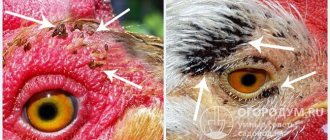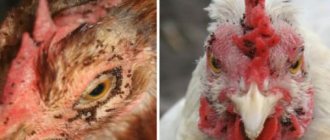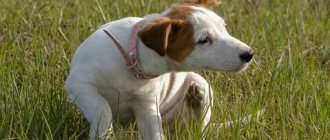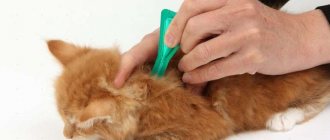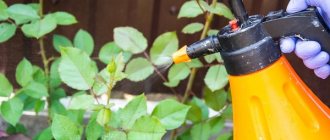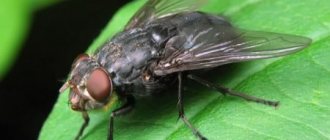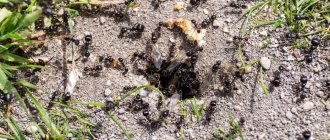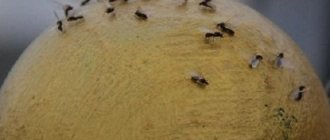Chicken fleas are a type of ectoparasite that feed on the blood of birds. Biologically they differ from their relatives that live on the fur of mammals, but for the owner of poultry these differences are insignificant. Fleas on a chicken look like dog or cat fleas, they jump well and multiply quickly in suitable conditions, populating the poultry house.
Appearance of chicken fleas.
Description and types
The chicken flea has a laterally flattened body, a dense chitinous cover and a developed piercing-sucking mouthparts. The bites are painful and cause itching in the bird.
Fleas are kept on the skin and feathers of chickens due to tenacious paws and numerous outgrowths and hairs. The hind pair of legs is well developed and allows the insect, if necessary, to make jumps of up to 1.5 m. Fleas begin to move in this way when the light levels decrease. During daylight hours, they crawl along the bird’s body closer to its hot skin or feed.
There are mainly 2 types of insects parasitizing poultry:
Appearance of a black flea.
- Chicken flea, Ceratophyllus gallinae. It is brown in color, body length is 2-2.5 mm. It lives on wild and domestic birds, attacks humans and mammals, and affects ornamental and songbirds.
Distributed throughout Europe and Asia.
- Black flea, Ceratophyllus niger. This species is often referred to as the Western chicken flea. Unlike the previous variety, it has a dark body color and a smaller size (1.5 mm).
It lives on different species of domestic and wild birds, and is capable of transferring to humans or mammals.
Ectoparasites have similar development and reproduction cycles and feeding methods. They carry the same diseases, so in the literature for farmers they are most often considered under the general name of chicken fleas.
Signs of skin parasites
A characteristic sign of parasitic infestation is a decrease in productivity. The number of eggs laid per week is reduced by up to 15%. This phenomenon should alert the poultry farmer.
Be sure to read:
What to do if the chicken begins to limp or the paw swells, treatment of leg diseases?
Characteristic manifestations of parasitic infestation among chicken stock:
- The bird is very worried and may begin to pluck its feathers and peck feathers.
- The livestock begins to consume a significantly larger volume of feed.
- The skin around the eyes, beak, and legs is constantly irritated, and inflammatory processes are possible. Feather cover may fall out.
- The skin is constantly damaged, peeling flakes of skin and minor blood stains appear on the earrings and combs of roosters.
- If pests damage the eyes, the bird can develop inflammation of the conjunctiva, accompanied by severe lacrimation and blurred vision.
- Fallen feathers will have characteristic holes, crevices, and cracks.
Features of parasites
The flat body and durable shell protect the insect well from being crushed by the beak or teeth of pets. Fleas are practically invulnerable to birds. By moving and biting the chicken, they make her restless and want to fiddle with her beak in her feathers. This does not lead to the destruction of the insect, and fleas reproduce unhindered.
A parasite dropped on the floor easily returns to the chicken or jumps onto another animal, a person. Can live in the litter until it is time to feed.
As they multiply, the parasites colonize the bird's skin, forming numerous colonies.
Visually, they can be observed in the form of small dark dots on open areas of the skin: most often on the head, near the earrings of chickens, guinea fowl, turkeys, or in the eye area of ducks and geese.
After leaving their host, chicken fleas live on other warm-blooded animals for a short time, but experience discomfort from the insufficiently high body temperature of piglets, humans or smooth-haired animals. This prevents reproduction, and insects move to objects more suitable for them.
The most common places for fleas to accumulate on chickens.
Symptoms
In the early stages of infection, it is almost impossible to determine the presence of chicken fleas in the chicken coop. Parasites live in the litter and inside the plumage of birds, where they are extremely difficult to see due to their small body size.
If the insect population reaches a large size, the first characteristic signs appear:
- anxiety and nervousness of chickens;
- birds often roll around in sand and dust, trying to clean themselves;
- scratches appear on the body;
- small red spots at the bite sites;
- egg production decreases;
- birds develop anemia, infected individuals quickly become exhausted.
With prolonged flea infestation, birds become weaker and practically stop eating and drinking. They react even to minor external stimuli (light or noise) and look extremely restless. As a result, they may die from nervous or physical exhaustion.
Where they come from and the life cycle
Fleas can enter a chicken coop on human clothing or cat fur, on bedding materials and food. Parasites reach the intermediate host from the external environment: from wild birds. Both types of chicken fleas are considered common parasites of tits and can be carried by pigeons and other birds living in urban and rural areas.
The life cycle is several months.
During this time, the female flea is capable of producing multiple clutches of eggs (daily). They hatch into legless larvae that resemble worms about 1 mm long. The larvae are able to live in the litter, feeding on organic debris, crawl onto chickens, absorbing the feces of adult insects and dead scales of the epidermis. After 7-14 days, the larvae turn into fleas and begin to reproduce.
Damage caused to chickens and humans from infection
Chicken fleas harm any bird they parasitize, regardless of breed, age, sex and fatness. As a result of constant bites, chickens develop nervous exhaustion, anemia, they eat poorly, lose weight, and sharply reduce egg production. In the most advanced cases, without assistance from a poultry farmer, they may die.
Fleas also pose a danger to humans, as they are carriers of serious infectious diseases. Among them:
- salmonellosis;
- trypanosomiasis;
- brucellosis,
- in rare cases - encephalitis and plague.
Insects are also carriers of helminth eggs and indirectly contribute to the spread of parasitic infections. Therefore, it is imperative to get rid of fleas from chickens, both for the sake of the health of your pets and your own.
Signs of appearance in a bird
The first symptom is expressed in increased nervousness of chickens: they often shake themselves, scratch their heads and necks with their paws, and finger the feathers on their chest and back. As the parasites multiply, other signs of infection appear:
- birds lose weight, growth slows down in broiler chickens;
- adult laying hens reduce egg production or stop laying altogether;
- the bird always looks unkempt, its feathers are ruffled;
- at an advanced stage of the disease, dark spots of ulceration appear on exposed parts of the body.
Upon visual inspection, lifting the feather, you can find brownish or black insects crawling quickly.
First aid
Often, a person who finds himself next to a patient does not know what exactly caused the intoxication and what to do in case of drug poisoning. In some cases, the first symptoms can be noticed only a few hours after taking the drugs. But there are several general rules for providing first aid. They are relevant for all severe cases:
- immediately call an ambulance;
- if a person is unconscious, but there is normal breathing and heart rate, it is necessary to lay him on his side;
- If a person is conscious and less than half an hour has passed since taking the medicine, it is necessary to give him a large amount of water and artificially induce vomiting. To do this, you need to press on the root of the tongue. If you do not know what poisoned a person, there is no need to induce vomiting;
- · After vomiting, give the patient a sorbent.
Drug poisoning. First aid for poisoning.
If a person is in serious condition, breathing slows down, the pulse is difficult to palpate, and artificial respiration must be performed. Remember that inaction can have fatal consequences.
It is necessary to show the emergency medicine packaging to the emergency doctors and describe the person’s condition. If you know that a person took alcohol along with the medicine, also tell the doctors about this.
Why are chicken fleas dangerous?
Flea reproduction and severe infestation become dangerous to the life and health of domestic birds. The need is due to the ability of parasites to carry infections (brucellosis, salmonellosis, trypanosomiasis), dangerous not only for birds, but also for humans and other inhabitants of the estate or summer cottage.
For the bird
Consequences of chicken fleas.
Constantly living on the chicken’s body and absorbing its blood, highly multiplied parasites cause anemia (anemia) in their prey.
The danger is great not only for young animals: general weakening of the body, decreased immunity and lack of appetite gradually make adult birds vulnerable to infectious and non-infectious diseases.
The lack of hemoglobin in breeding hens also affects the quality of the hatching egg.
By carrying pathogenic microorganisms, chicken fleas increase the risk of infection of a large number of chickens, waterfowl and other farm animals.
For man
When a chicken parasite bites, the following pathogens can enter the human bloodstream:
- encephalitis;
- brucellosis;
- pseudotuberculosis;
- salmonellosis and other dangerous infections.
If microbes of the staphylococcal group get into the scratching areas, there is a possibility of ulcers. Allergy sufferers have a reaction to insect feces.
Fighting chicken fleas is necessary not only for the well-being and increased productivity of feathered pets, but also to preserve the health of adults and children who come into contact with domestic animals.
How is a chicken coop disinfected?
Experienced breeders who have dealt with parasites recommend the following for a chicken coop:
- Cucaracha emulsion;
- aqueous suspension of Karbofos;
- Tetrix concentrate;
- concentrated emulsion Deltsid;
- Get suspension.
Deltamethrin is also applicable. If the plan is to disinfect the poultry house with a preparation in the form of a powder, you will have to acquire (borrow) a dust sprayer.
The disinfected room is left alone for three days. This time is enough for the parasites to die. The bird returns after replacing the bedding, updating the nests, and removing droppings. Pouring boiling water over surfaces is also effective, and an alternative is burning with a blowtorch. You can refuse heat treatment. Then the surfaces will have to be whitened.
The premises are inhabited by chickens after two disinsections! The interval between them is two weeks.
Fighting methods
Chickens cannot get rid of a large number of parasites on their own. To remove them, you can use different methods of fighting: traditional and modern. All of them are aimed only at destroying parasites.
Chicken coop treatment
Fleas live in the litter, crawl into cracks and can reappear after simple cleaning. At home, winter premises are treated after transferring the birds to the summer barn:
- clear the room of litter;
- spray the selected preparations;
- the treated barn is closed for 8-24 hours, according to the instructions for the pesticide.
The summer premises must be prepared for the transfer of birds in advance. To eliminate the possibility of fleas being introduced into a clean chicken coop, birds are subjected to treatment procedures on the day of moving.
Poultry processing
Infected chickens or other poultry breeds must be treated for parasites. To do this, use drops against fleas for dogs and cats (Bars, Dana, etc.), applying them in the same way as on animals: at the base of the neck, between the shoulder blades, on the back of the neck, where it is difficult for the bird to reach the emulsion with its beak.
For flea protection and treatment, you can call a veterinarian to your home. Injections of the drug Ivermectin and similar products quickly and effectively get rid of skin parasites.
Deltamethrin powder is used to sprinkle the bird's feathers and skin if fleas have already infected laying hens. The powder can be added to ash baths to allow chickens to bathe on their own. To treat domestic birds, Butox or other preparations are used, spraying the solution onto the feathers and down.
Chemicals: review of products
Butox solution for treating chickens.
In modern farms, it is convenient to use aerosols and solutions (emulsions) based on permethrin, karbofos and other toxic substances intended to combat crawling insects, these are:
- a solution of Butox (dilute the contents of the ampoule with water according to the instructions), Tetrix, Cucarachi and other drugs is sprayed with a spray bottle or garden sprayer;
- Deltamethrin is a powdered preparation and is suitable for dusting nesting boxes, floors and other surfaces, chickens or ducks themselves using special equipment;
- Raptor, Kombat, Karbofos, Raid, etc. are ready-made sprays, used according to the instructions on the package (spray all accessible surfaces), it is not recommended to treat poultry.
After spraying toxic chemicals in the chicken coop, the room is closed for a period of several hours to 1-2 days. During this time, most of the parasites will die. Ready-made sprays with permethrin, cypermethrin, deltamethrin (Raid, Raptor, etc.) are especially effective.
Small drops seep into any cracks. They act by penetrating the body of insects and cause their death within a few hours. Low toxicity for warm-blooded animals. The decomposition of the pesticide occurs within 1-4 weeks.
Traditional methods
Treating chicken fleas with Deltamethrin.
Traditional methods of controlling chicken fleas are based on the bird's instinctive behavior in getting rid of any skin parasites. Birds take dust baths, falling out in sand, dry soil, etc.
At home, wood and coal ash are a good remedy. It is poured into flat containers and placed in the poultry house so that the baths are always accessible.
If there is a strong proliferation of parasites in the ash, you can add sulfur powder (buy at a veterinary pharmacy or garden store), Deltamethrin or crushed herbs (wormwood, Persian chamomile, etc.).
Traditional methods include the separate use of medicinal plants.
Application of herbs
The ability of a number of plants to repel fleas has long been appreciated by humans and is used to treat not only dogs and cats, but also poultry. The following can be used in a chicken coop:
- infusions and decoctions of aromatic herbs;
- powder from dried plants;
- alcohol tinctures based on poisonous flora.
Aromatic herbs are used to repel parasites. Their essential oils are unpleasant to fleas, and the parasites quickly leave the house. The following varieties can be used:
- lavender;
- tansy;
- juniper;
- geranium (houseplant);
- rosemary;
- pyrethrum;
- wormwood, etc.
To repel fleas, it is convenient to use powder from these herbs: the dried raw materials are ground and scattered throughout the chicken coop, paying special attention to the nesting boxes. Chickens and their related species do not have a developed sense of smell, and it is impossible to frighten them off with odors, but the larvae and adults of fleas and ticks most often live in the litter of nests.
The powder is also added to ash baths at a ratio of 1:1. A simple bathing procedure for a chicken becomes therapeutic if fleas have already attacked its feathers.
In addition to the dry method, strong decoctions of aromatic raw materials are used to treat the chicken coop. You can brew 3-4 tbsp. l. crushed wormwood, tansy and other herbs, pouring boiling water over the plants. It is most convenient to infuse in a thermos, leaving the liquid overnight. Spray the shed when cleaning using a spray bottle.
Poisonous plants are also used to kill fleas:
- wild rosemary;
- pyrethrum (Persian chamomile);
- hellebore.
These varieties can be infused with vodka by combining 50-70 g of dried raw materials (or about 250 g of fresh herbs) and 0.5 liters of alcohol. Leave for 2 weeks in the dark, after which the medicine can be stored for 2-3 years, using as needed. A warning label must be placed on the container as the liquid is poisonous. Keep out of the reach of children.
If necessary, use the tincture as follows:
- Using a sprayer or swab, apply the drug to the bird’s skin to kill fleas on it;
- spray all surfaces, cracks, corners in the chicken coop, and when keeping cages, treat both the cages and the room;
- remove and burn the bedding from the nest, spray the box and lay down new material.
How to get rid of fleas from chickens using traditional methods?
Helps get rid of external parasites:
- dry baths;
- aromatic herbs - wormwood, marigold, tansy are well suited for these purposes;
- Birch tar.
Dry baths for cleaning plumage
To clean the pen, use a mixture of sand, ash, and sulfur. The last component is not necessary, but it enhances the effect of such bathing. Ash and sand are combined in a 1:1 ratio. 50 g of feed sulfur is added to 3 kg of the mixture.
Fragrant herbs
Wormwood, tansy, pyrethrum, and marigolds save chickens from fleas. Wormwood is harvested during the period of active flowering, from July to August. Use sharp pruning shears to cut off the tops. Tansy is harvested at the beginning of flowering, only the tops are collected. Marigolds are harvested from July to September, cutting the plants at a height of 15 cm from the ground. Pyrethrum (maiden chamomile) is harvested before flowering; the leaves are the most valuable. Dry the raw materials under a canopy, spreading them out on a horizontal surface.
Depending on the type of raw material, the grass is hung in bunches in the chicken coop or placed in fabric bags. Particular attention is paid to areas where the livestock spends the most time. As the aroma fades, the raw materials are renewed.
For bathing, prepare a decoction at the rate of 60 g of dry grass per 1 liter of water. The liquid is brought to a boil, allowed to brew and cool, then filtered. To enhance the effect, add a little apple cider vinegar (1 tbsp/1 l). Dip the chicken up to the neck into the broth at a comfortable temperature, moisten the head with your hand. After this procedure, the bird is temporarily placed in a separate clean room to dry.
For dry processing, you can use pyrethrum powder. The grass, crushed to a dusty consistency, is rubbed into the skin, lifting the feathers. You should wear a respirator to avoid inhaling flying particles.
Before starting treatment, it is worth checking the reaction to the product used to exclude individual intolerance.
Essential oils
You can use ready-made essential oils of wormwood or pyrethrum. They are used to make flea spray for chickens. In 1 tbsp. l. 25 drops of oil are dissolved in alcohol, mixed and 250 ml of water are gradually added. The solution is placed in a spray bottle. Each individual is treated individually, lifting the feathers and spraying them.
Birch tar for treating chickens against fleas
This product is made on the basis of birch bark. It is harmless to poultry and has an antiseptic effect. Birch tar is a dark-colored oily liquid. It is rubbed into bitten areas of the skin and applied to scratches. Tar promotes rapid healing of wounds and reduces itching. The strong smell repels insects.
You can treat the poultry house. The litter is removed. Dry sawdust is impregnated with tar and left for an hour (proportion – 1:8). In a large basin, the coal is brought to a state of smoldering, and sawdust is distributed on top. The birds are taken out of the chicken coop. The cracks are sealed. The frying pan is placed inside, placed on a non-flammable substrate. The treatment is carried out for three hours. After this, the room is ventilated.
Preventive actions
To prevent fleas from appearing in the poultry house, methods should be used to repel them and treat ceratophylllosis in the early stages (when chickens can still expel the parasites themselves by bathing in ash). The main carrier of fleas is wild birds, so it is advisable to protect feed and bedding materials in the poultry house from them, and limit the penetration of tits and sparrows into walking yards.
If a new batch of birds is purchased, they can be released into the general flock only after quarantine measures.
During this period, new hens or chicks are kept separately (5-7 days), assessing not only the presence of fleas, lice and other parasites, but also diseases. If ectoparasites are detected during a visual inspection, treatment is carried out with chemicals or folk remedies to destroy them.
Reasons for appearance
Fleas are infested in the feathers through direct contact with an infected individual or as a result of the introduction of parasite eggs into the chicken coop and onto the walking yard by wild birds and rodents. Housekeeping staff can also transfer flea eggs on clothing or shoes. The source of the spread of ectoparasites is often equipment borrowed from an infected poultry house. The active development of the colony is promoted by:
- unsanitary conditions;
- rare replacement of bedding on the floor and in nests;
- high temperature and high humidity in the room;
- crowding.
Habitat disinfestation
When infested with fleas, both the bird and the habitat (cage) are treated. For this purpose, they choose the same drugs that were used to treat the bird. Completely wash all elements of the cage, food and drinking containers. After this, you will need to take everything out into the fresh air for ventilation (from 3 to 6 hours). Toys and mirrors are thrown away.
During the treatment, the parrot is sent to another home, but pre-treated with soda, manganese or another flea remedy. When treating pigeons, birds are allowed into the dovecote only after 6-8 hours. All bedding, hay and other things are taken out and burned.
Prevention is the key to bird health
Preventive measures will help avoid repeated or primary flea infestation if you use:
- baking soda. Add 1 tsp to 200 ml of boiling water. soda Steaming helps chemical reactions take place. Regularity of processing the parrot's cage, bedding, and dishes - once a week;
- weak manganese solution or turpentine liquid. The second option is more effective. Manganese is used to disinfect the bird's home during hatching.
In addition to treating the cage, drinking containers, and food, the entire apartment is disinfected. Potassium permanganate or turpentine is also suitable. Medicinal herbs are called an excellent preventive remedy.
Bird handling rules
Regardless of the product you choose to treat your feathered pet, you should remember the safety rules for the life of the bird. When using strong chemicals, the bird is carefully handled. Only the skin is processed. To prevent the product from getting on the head and eyes, make caps.
Baths are made warm, not hot. The bird's head is also supported so as not to get wet. If a parrot is treated with a herbal solution or medicinal liquid through a spray bottle, it is recommended to put a cap on the head. This will help prevent the medication from getting into your eyes.
What harm do fleas cause to birds?
Chicken fleas are quite dangerous for birds, causing a lot of inconvenience, pain and seriously damaging their health. The saliva secreted by parasites contains irritating particles that cause itching and allergic reactions.
In addition, insects are capable of:
- provoke a sharp weight loss;
- cause the appearance of tuberculosis, salmonellosis;
- provoke chicken anemia;
- deplete the bird’s body, causing chronic diseases;
- cause the death of chickens.
If you promptly help a chicken get rid of parasites, you can not only prevent a flea epidemic, but also completely restore the health of the affected bird. After treatment, she will quickly return to her usual lifestyle, and within a week you can expect good egg production.
